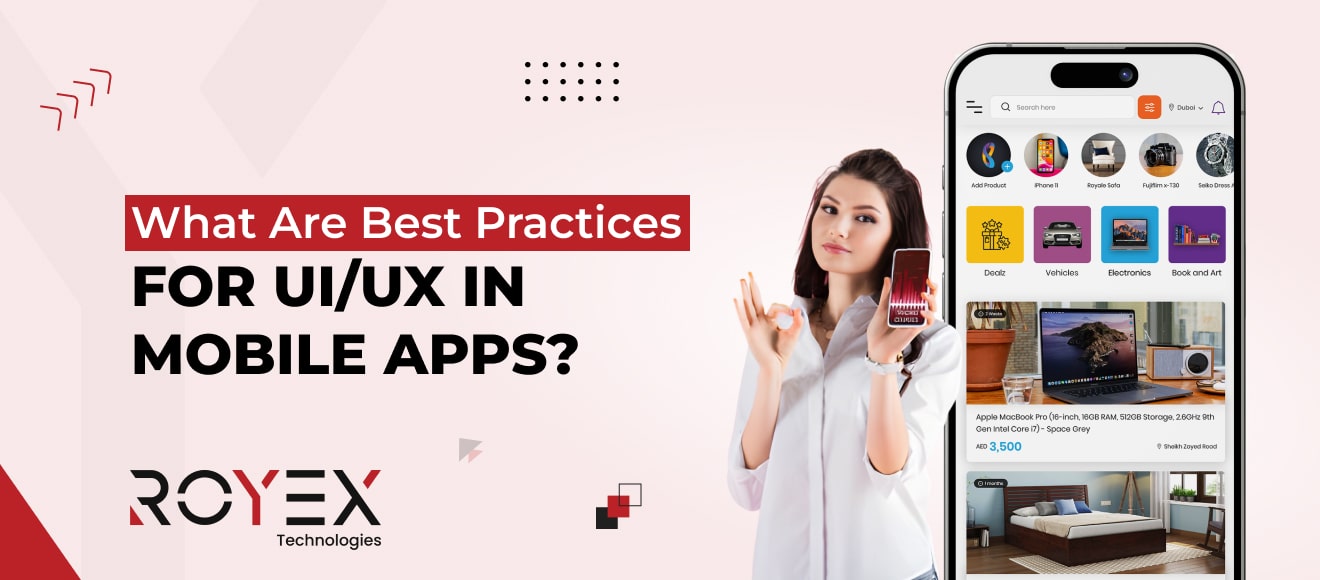
What Are Best Practices for UI/UX in Mobile Apps?
Series note
Based on common questions asked by our customers before developing mobile apps, we have listed most of the questions and answers in detail for each of the questions. This article is part of our series “Mobile App Journey: Things You Must Know.”
Introduction: Why UI/UX Defines Mobile App Success
The mobile app world is crowded and unforgiving. With over 8.9 million apps available across Google Play and Apple’s App Store, but only about 30 apps used monthly per person, competition is brutal.
In this environment, UI (User Interface) and UX (User Experience) are no longer nice-to-have—they are the make-or-break factors.
-
88% of users are less likely to return to an app after a poor experience (Forbes usability report).
-
80% of users uninstall an app after using it once if it’s buggy or confusing.
-
Global research shows 25% of apps are abandoned after just one use, mostly because of bad design or complex onboarding.
Good UI/UX increases retention, engagement, conversions, and brand loyalty. Poor design means wasted development cost and a failing product.
This article will walk you through:
-
Core principles of mobile UI/UX
-
Design methods and frameworks used by modern teams
-
When to use which method (with examples)
-
Trending design patterns in 2025
-
Why skipping best practices leads to app failure
-
Why Royex Technologies is your best partner for UI/UX-driven app development
Core Principles of Mobile App UI/UX
1. Clarity First
-
Every screen should have one main purpose.
-
Users should instantly understand what to do next.
-
Use simple language (no jargon).
-
Highlight the primary action with color and hierarchy.
2. Consistency Across the Journey
-
Same navigation logic across all screens.
-
Consistent fonts, button styles, and icons.
-
Predictability builds trust.
3. Efficiency & Speed
-
Optimize flows to minimize taps.
-
Use shortcuts, autofill, and smart defaults.
-
Design for one-handed use (important in commuter-heavy markets).
4. Feedback & Response
-
Loading indicators, animations, and error messages reassure users.
-
Lack of feedback = frustration.
5. Accessibility
-
Color contrast for visibility.
-
Support voice commands and screen readers.
-
Larger tap targets for people with motor limitations.
Design Methods & When to Use Them
1. Wireframing & Prototyping
-
Tools: Figma, InVision, Adobe XD.
-
Purpose: Test structure, navigation, and flow before heavy coding.
-
When to use: Early in design to validate app flow with stakeholders and test users.
-
Why important: Cheap way to fix usability issues before development.
2. Human-Centered Design (HCD)
-
Approach: Puts user needs, behaviors, and contexts at the center of design.
-
Process: Research → Ideate → Prototype → Test → Refine.
-
When to use: Always—especially for apps solving daily life challenges (health, finance, education).
-
Impact: Increases adoption because designs fit real-world user behavior.
3. Design Thinking
-
Approach: Problem-solving framework used by leading product teams.
-
Phases: Empathize → Define → Ideate → Prototype → Test.
-
When to use: Complex apps with unclear problem scope.
-
Example: Creating an app for rural farmers—requires empathizing with their context before ideation.
4. Lean UX
-
Approach: Focuses on rapid iteration and testing instead of heavy upfront documentation.
-
When to use: Startups and MVP projects.
-
Why important: Saves time by focusing on validated learning.
5. Agile UX
-
Approach: UX work integrated into Agile sprints. Designers and developers collaborate in real-time.
-
When to use: Large, evolving projects with multiple releases.
-
Benefit: Continuous feedback, faster improvements.
6. Atomic Design
-
Approach: Breaks UI into reusable components (atoms, molecules, organisms).
-
When to use: Enterprise apps, e-commerce, and products requiring scalable design systems.
-
Benefit: Speeds up development and maintains consistency across large projects.
7. Gamification Design
-
Purpose: Apply game mechanics to increase engagement.
-
Techniques: Badges, progress bars, levels, streaks.
-
When to use: Fitness apps, learning platforms, finance savings apps.
-
Why important: Research shows gamification boosts engagement by up to 60% in habit-forming apps.
Trending Mobile App Design Practices (2025)
-
Neumorphism + Minimalism Hybrid
-
Soft shadows and 3D-like buttons combined with minimalist layouts.
-
Creates a modern yet clean feel.
-
-
Dark Mode by Default
-
81.9% of users prefer dark mode on their devices (UX Collective survey).
-
Essential for readability and battery savings on OLED devices.
-
-
Micro-Animations & Motion Design
-
Small animations guide users (e.g., button ripple effects).
-
Provides feedback, delight, and smoother navigation.
-
-
AI-Powered Personalization
-
Personalized feeds, smart suggestions, predictive search.
-
Example: Spotify recommending playlists based on mood.
-
-
Voice & Gesture Interfaces
-
Increasing integration with Siri, Alexa, and Google Assistant.
-
Gesture-driven controls are growing in AR/VR apps.
-
-
Inclusive & Accessible Design
-
Multi-language support, voice-to-text, dyslexia-friendly fonts.
-
Growing demand as apps target diverse global users.
-
-
AR/VR & Mixed Reality UI
-
Popular in gaming, shopping (virtual try-ons), and real estate.
-
By 2025, 1.4 billion devices support AR features worldwide (Statista).
-
Best Practices by App Category
-
E-commerce: Simplify checkout, integrate mobile wallets, show trust badges.
-
Healthcare: Clear typography, HIPAA-compliant data flows, emergency access.
-
Fintech: Simple dashboards, intuitive charts, biometric login.
-
Education: Gamified learning paths, offline mode, easy navigation for students.
-
Social: Infinite scroll, stories, push notifications—designed carefully to avoid overload.
What Happens If You Skip UX Best Practices?
-
Confused users: Drop-off during onboarding.
-
Low retention: Remember, 25% of apps are abandoned after one use.
-
Bad reviews: A buggy or ugly app sinks in app store rankings.
-
Lost revenue: Studies show that every $1 invested in UX returns $100 in ROI (Forrester).
Why Royex Is the Best Company for Mobile App Development
At Royex Technologies, we treat UI/UX as the core of app success—not an afterthought.
-
Discovery Workshops: We conduct deep user research before design.
-
Design Excellence: Our team uses Figma, Lean UX, and Atomic Design to deliver scalable, consistent, and beautiful interfaces.
-
Tech Stack Expertise: Flutter for mobile apps, ASP.NET Core for admin dashboards, MSSQL for databases.
-
Trend Awareness: We implement dark mode, personalization, micro-animations, and AR/VR features where relevant.
-
Proven Track Record: 500+ projects delivered since 2013 across industries like retail, health, fintech, and transport.
-
User-Centric: We align every decision with the user’s journey—ensuring your app is loved, not just downloaded.
Statistics Recap
-
8.9 million apps in app stores, but only 30 used monthly per user.
-
88% of users won’t return after bad UX. (Forbes usability)
-
80% of users uninstall apps after one buggy/confusing session.
-
25% of apps abandoned after one use.
-
81.9% of users prefer dark mode. (UX Collective survey)
-
$1 spent on UX = $100 ROI. (Forrester research)
-
1.4 billion devices support AR features by 2025. (Statista forecast)
Conclusion
The best apps are not the ones with the most features—they are the ones with the best experiences. UI/UX is the silent engine of adoption, engagement, and retention.
By following proven best practices—human-centered design, Lean UX, gamification, accessibility, and embracing 2025’s trends—you can create apps that don’t just sit on devices but become part of people’s daily lives.
If you want to ensure your app combines cutting-edge UI design with rock-solid UX strategy, Royex Technologies is the partner who brings both creative expertise and technical excellence to the table.
We are a leading mobile app development company in Dubai, that provides innovative solutions for small, medium, and large-scale companies. We specialize in responsive web development, mobile app development, CRM integration, AI solutions for website & mobile applications, and many more. Our extensive experience in mobile app development will help you to take your business to a high level.
Check our portfolio to see our previous works. Contact us via email at info@royex.net or call us at +971566027916 to get started with us.
Sources
-
Business of Apps – How many apps are in the app stores (2024)
-
Statista – Buggy apps lead to high uninstall rates (2024)
-
Localytics – App abandonment statistics (2023)
-
Forbes – Usability impacts retention (2019)
-
UX Collective – Dark mode preference survey (2023)
-
Forrester – ROI of UX investments (study)
-
Statista – AR devices forecast for 2025





